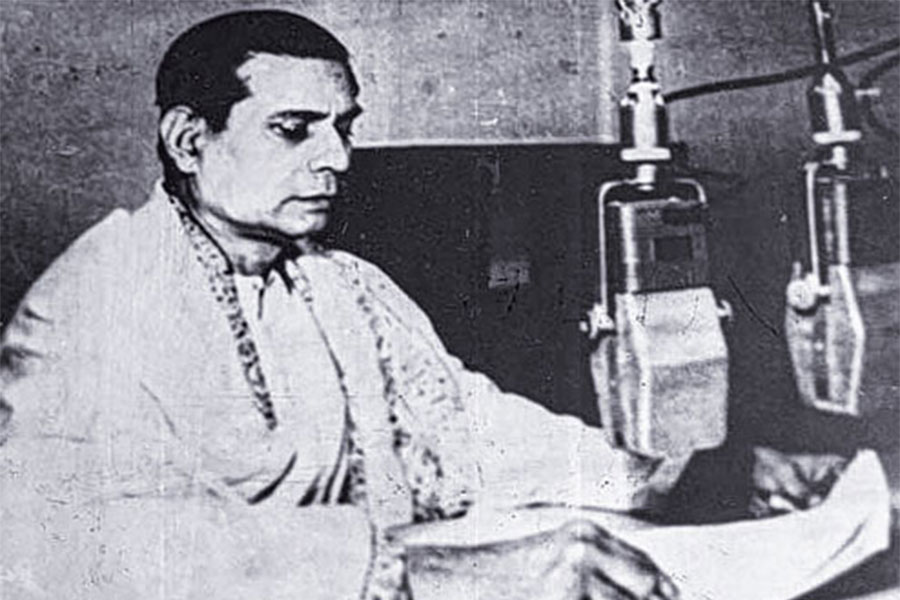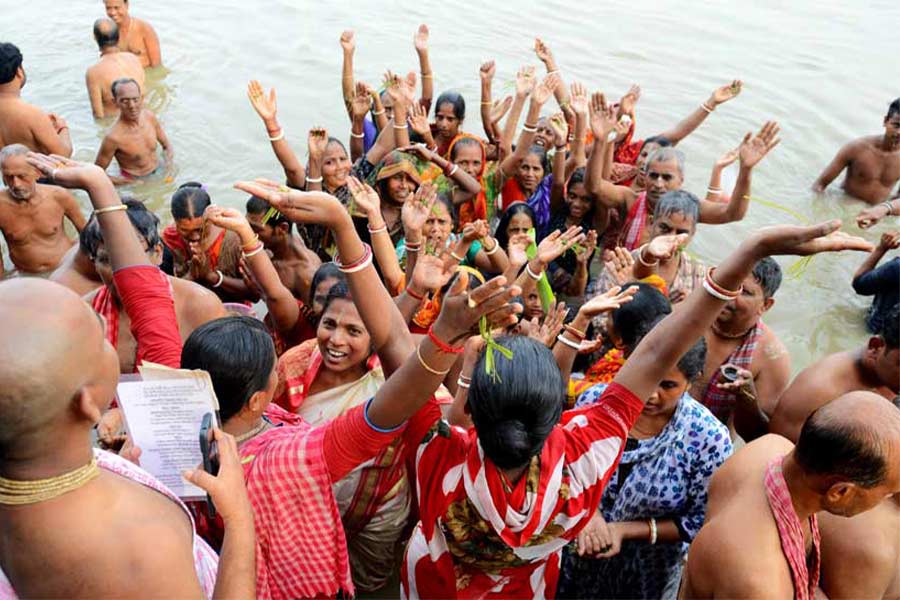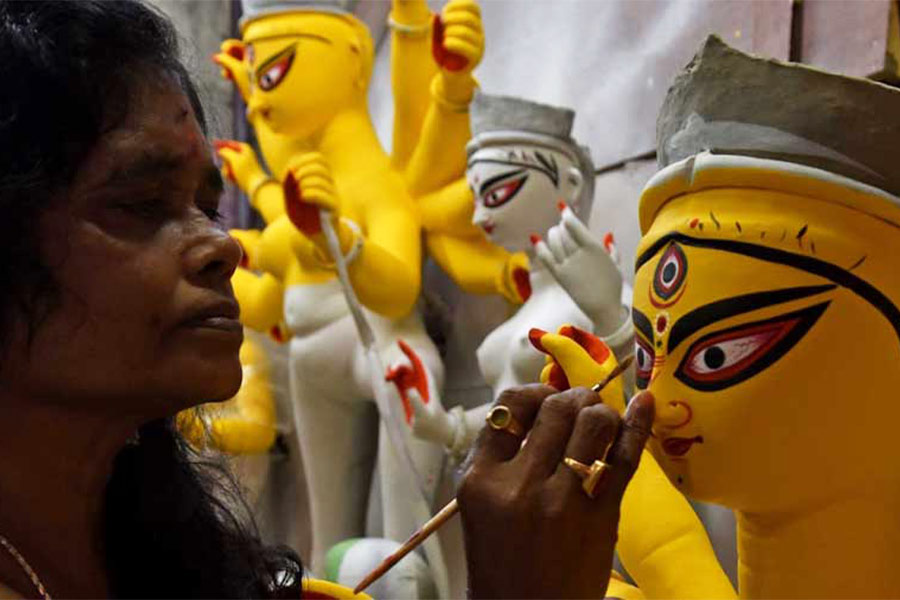When it sprouts as a hushed shoot at four in the morning, we know soon it will spread and fill out every inch of our mind’s and memory’s space. We also dwell silently on the ages-old words and sentiments: “Here is Devipaksha. Finally! And so is Pujo...”
We refer to Mahishasuramardini. The fond staple on radio on the dawn of Mahalaya — when Pitripaksha ends and Devipaksha begins.
A voice. Or a clutch of voices. Voices that rise — even though for an hour or so — above the miseries of a battered, buffeted, abused society and transport us to various associations of life. For some, it’s religious; for some, an outpouring of nostalgia; for others, relishing goosebumps-y narrations and songs that have been playing an integral part in their growing and grown-up years. For some families, it’s rather early cups of bed tea, sipped together. Not that every resonance of rich Bengali or Sanskrit and every vibration of every song rouses the listeners from an envelope of sleep. Yet, the notes do wrap them up like a cobwebby cloak. The high-decibel and mighty rendition of an epic battle, how and why it started, songs — some delicate, others robust — are pure magic. We give in to it willingly and happily. And to the timeless trio of Banikumar, Birendrakrishna Bhadra and Pankaj Mallick, as well as to a number of wonderful singers and musicians.

Earlier, Mahalaya morning radio fare was an occasion for unpremeditated family gatherings TT Archives
Years earlier, the Mahalaya morning radio fare was an occasion for unpremeditated family gatherings. As if everyone just had to come together – in the company of a radio set – the sleepier ones strolling in a little later maybe – and listen to the same story, the same voices taking flight into a world so far removed from our own. A few listeners waited for their favourite songs to reappear. Bajlo Tomar Alor Benu, Jago Tumi Jago or Ogo Amar Agomoni keep revoking childhood memories. Chandipath has always woven its special magic.
Times have, irrevocably, changed. Television joined in, with its sundry programmes, adding visuals, colours, actions to the lattice radio had created. Then came mobile phones, and now even if you miss the 4 o’clock All India Radio Mahishasuramardini, you can listen to it whenever you wish. Well, the magic is in the mind, people say. Debate that if you wish...
These days, of course, most neighbourhood clubs have somewhat done away with the delicate bit of voices rising at dawn. To them, decibels matter. Mashishasuramardini is played on loudspeakers here and there, and our ears cannot miss it.
By the time the Devi slays the demon, peace and calm descend on a primeval battlefield and chants of prayers soar to the heavens, the autumn sun looks somewhat benignly on a lazily waking city. Waking a little later than usual — maybe — because, Mahalaya is a holiday for most of us.
It is now that the Hooghly – the river called so as it is about to reach the sea – and its banks wake up to a special ritual called tarpan. A ritual one can certainly perform in the privacy of one’s home. Or, it can be done in a more elaborate manner. A lot of people prefer it that way. Right on the ghats of the Hooghly, guided by the priests, surrounded by fellow worshippers, people pray for the departed souls, offer water, sesame seeds and other essentials to ancestors, sages, deities, and souls they once knew and held close to heart. The mantras are particularly compassionate in sections which underscore the import of not forgetting those who are unrelated, who have met unfortunate ends, or those who have not been sent off in peace and love. A walk down Jagannath Ghat, Babughat, Bagbazar Ghat, Kashi Mitra Ghat, Ahiritola Ghat, Bichalighat, Judges’ Ghat, Nimtala Ghat, Gwalior Ghat and others brings up images that are replete with timeless symbols.

Devotees rejoice after ‘tarpan’ at one of Kolkata’s ghats TT Archives
Symbols of abiding faith, of enduring rites and traditions, and of beliefs that linger despite hundreds of overwhelming changes taking over. Besides, who knows, those paying homage through tarpan on Mahalaya might just sense a momentary thread of connect with the dear and the departed...
The Mahalaya morning acts as a prelude to the extraordinary five days that wait in the wings – only to reveal themselves on Sasthi approximately a week later. And because Mahalaya acts as an auspicious transition – plus tarpan is a precious ritual for the believer – thousands and thousands of devotees gather on the Hooghly ghats to pay obeisance to their forefathers, causing serious headache to the elaborate police forces keeping vigil. Cops need to be alert that no accident takes place – high tides in the river sometimes pose a threat – and any other untoward incident is avoided. The river traffic police keep watch as well.

The quiet and private niches of home are ideal for ‘tarpan’ as well TT Archives
The quiet and private niches of home are ideal for tarpan as well. Here too memories and narratives flood the mind; memories of those gone long ago, of others who left just like that, as well as narratives of many felled by wars, famines, arsons, brutal, callous attacks or by natural calamities. Not related to us, probably. But we have shared the same planet, we have breathed the same air, looked up at the same sky. And, going by that strain of likenesses, we are kindred spirits. Hence, the silence of home is perfect for paying homage to those souls on Mahalaya.
We end the period of mourning or Pitripaksha on Mahalaya. We love to believe that the Goddess Durga and her entourage start the descent to the earth on this day for the annual Puja. Endearing thoughts, even in these troubled, harried times.
As we perform tarpan on this Mahalaya morning, let us offer the first drops of water (satilagangodakang) – whether on the river banks or at home – to peace.
